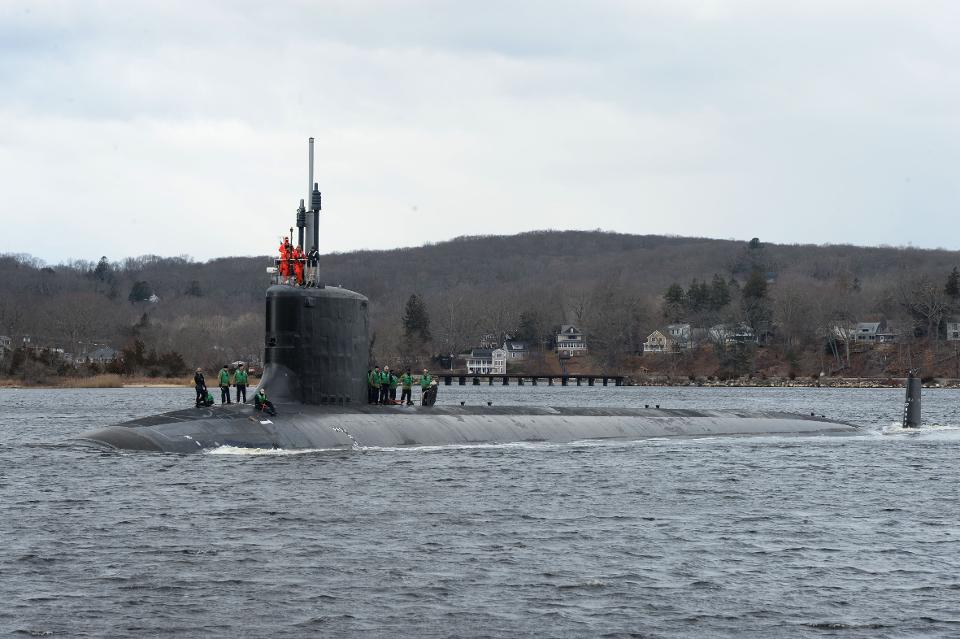USS Gerald R. Ford needs to spend more time in a shipyard before going into contested waters. (Photo/Steve Helber)
ASSOCIATED PRESS
The U.S. Navy has an enormous amount of credibility and prestige riding on the outcome of two post-delivery refits. Now, in naval shipbuilding, post-shakedown availabilities are usually mundane affairs where the naval customer makes a few final fixes. But today, the U.S. Navy is counting upon the successful completion of extensive post-construction modifications on the USS South Dakota (SSN 790), a brand-new Virginia class submarine, and the first-in class USS Gerald R. Ford (CVN 78) super-carrier.
Both refits are larger and more complex than usual, and they both aim to help the U.S. fleet leverage a host of ambitious next-generation technologies. But a successful outcome is far from guaranteed. In Norfolk, Virginia, the USS Gerald R. Ford, a new $13-billion-dollar nuclear-powered aircraft carrier, is struggling to achieve combat-readiness. The new electromagnetic technologies aboard the ship and innovative energy-distribution methods are proving to be difficult to master and then apply to elevators and other “old-fashioned” or “legacy” systems. And, farther north, tucked away in Connecticut’s Electric Boat shipyard, the $2.6-billion dollar USS South Dakota is quietly receiving an intensive refit to ensure America’s continued superiority in the undersea domain.
Both programs are ambitious feats of engineering. And, like any ambitious technical endeavor, complete perfection may prove an elusive goal. Some new high-tech concept or fancy weapon aboard either craft may not meet naval requirements or just may not work when introduced to the rigors of naval service. But balancing that risk with the fleet’s overarching need for technological advantage is a time-honored and persistent challenge for naval stakeholders. America, however, after cruising to a Cold War victory with one of the most advanced naval fleets in history, has gotten far too complacent about managing technological risk at almost every level.
Managing technological risk is neither easy nor cheap. Understanding complex systems demands a tough, rigorous and interdisciplinary effort as well as a willingness to recognize and report error. Systems engineering is hard and inadvertent mistakes are inevitable—particularly at times when the Navy is undergoing a fundamental systems refresh.
As the U.S. Navy fleet accelerates away from old Cold War-era platforms and practices, policymakers are eager to help the Department of Defense do a better job of managing risk, facilitating prudent risk-reduction. Big steps like full-scale prototyping at a system and platform level to enforcing accountability for technological miscalculation are viable tactics, but the Navy would be wise to also consider some potentially easier routes to reduce risk.

The Virginia-class attack submarine Pre-Commissioning Unit (PCU) South Dakota (SSN 790) transits the Thames River before being commissioned.
U.S. Navy photo by Mass Communication Specialist 1st Class Steven Hoskins
Outcomes Matter
Outside of the complex engineering contributions to risk, one of the simplest ways to manage technical risk is to manage stakeholder expectations. With the Navy’s two big post-delivery refits, the responsible naval communities have taken two very different paths in managing expectations. For the USS Ford, success has become the only acceptable outcome, while, aboard the USS South Dakota, success will be defined by what the undersea community learns from the platform.
To that end, the Virginia class attack submarine USS South Dakota is a centerpiece of the Navy’s longstanding and highly classified Acoustic Superiority Program. When the refit is done in late 2020 or early 2021, the sub will serve in the Fleet as a combat-ready test-bed and technology demonstrator, helping U.S. submarines avoid detection and find adversary boats first. The USS Ford is an equally ambitious project, changing the way the Navy launches and recovers aircraft, distributes electrical power aboard ships as well as how the Fleet detects, identifies and responds to surface, airborne and other threats.
Naval advocates for both platforms have taken very different approaches to their projects. Proponents for the USS Ford have, at every turn, portrayed the vessel as a platform that will be battle-ready from the vessel’s first day in the Fleet. This makes sense. As a rising member of the House Armed Services Committee, Congressional Representative Elaine Luria (VA-2), emphasized recently, “The Nation does not have the luxury of a $13 billion experimental aircraft carrier. The fleet has been strained while operating below the 11-carrier mandated force since the inactivation of USS Enterprise in 2012.”
But expectations were also not managed within the Defense Department. According to naval tastemaker and Center for Strategic and Budgetary Assessments Senior Fellow Bryan Clark, “To satisfy Secretary of Defense Donald Rumsfeld’s demand for “transformational” capabilities during the early 2000s, the Navy pulled forward into the Ford a dozen new technologies that, Navy leaders argued, would reduce the cost and manning required for the ship and dramatically improve its firepower relative to the Nimitz-class carriers. At the same time, Navy leaders assured Secretary of Defense, Congress and industry that carrier production would continue on its existing schedule, rather than admitting maturing the Ford’s new technologies may take several years and could introduce a gap in construction.”
While the delicate programmatic cycling and tasking of America’s limited carrier fleet barely budged, the vast redesign-driven incorporation of some twenty brand-new technologies suggested substantial system, platform and fleet integration challenges.
Making matters worse, the Ford class innovations were not fully thought through at a systems—or even really at a strategic—level, which has led to a series of tactical, technical and operational shortcomings in naval systems engineering efforts. “The Navy’s investments in new technology should not be for technology’s sake alone,” admonished Representative Luria, speaking with authority after a twenty-year naval career operating and maintaining nuclear aircraft carriers. “Each technological change should provide increased lethality, needed capability, better efficiency, and be easier to operate and maintain. In the Ford class design process, it is clear that these criteria were not met.”
Even today, as shipbuilders struggle to get critical weapons elevators to work aboard the USS Ford, carrier advocates within the U.S. Fleet are reluctant to face the consequences of shifting the deployment schedule to reflect the hard truth: The USS Ford is simply not battle ready. It is an experiment with many refits to go before it can safely venture into contested seas.
The press to meet deployment targets has served as a risk-reduction measure of a very different sort. In fact, the USS Ford’s first deployment, originally expected to take place next year, has long been a cudgel for a Navy eager to sidestep picky developmental evaluations and tough performance milestones that are in place to force the Navy to openly acknowledge and fix problems before they compromise the platform.
Inevitably, the new carrier bogged down in sea trials, and, despite recent optimistic news about the carrier’s power plant and aviation recovery systems, the USS Ford’s first refit seems to be headed for a poor outcome. The carrier has had plenty of time; the USS Ford’s originally planned six to eight month post-delivery availability grew into to a combined post-shakedown availability/selected restricted availabilityPSA/SRA of twelve months, which then grew again by three months. At present, the carrier is due to leave the shipyard in October of 2019, and yet, sources say, only two of the USS Ford’s eleven mission-critical elevators—and none of the elevators used to move ammunition between decks—are operational. Refitting broken elevators in the heart of an enormous, fully-fabricated ship is a daunting task that will take far more time than the Navy wishes to admit.
Without additional refits, the U.S. may send an unready carrier into contested seas.
In contrast, the normally tight-lipped submarine community has been forthcoming about their technological aspirations, publicly revealing the USS South Dakota project in mid-2016, re-emphasizing their plans during the boat’s February 2019 Commissioning, and then quietly embarking on the refit a few months ago. But while the technological goals are equally ambitious and the outcome just as important for national security, the submarine community has taken great pains to explain that while the USS South Dakota is a combatant, the submarine’s primary role for the immediate future will be to serve as a technology demonstrator, proving out silencing concepts for the rest of the Virginia class, the future Columbia (SSBN 826) class ballistic missile submarines and, potentially, informing a future new attack submarine design. By framing this pricey refit as a research effort, and by being realistic about dedicating the platform’s immediate future to tests and trials, the Navy’s undersea community has done a wonderful job of managing stakeholder expectations.
Conclusion:
Both projects may fail. But the U.S Navy’s submarine community, by emphasizing the experimental aspects of the USS South Dakota refit, effectively insulated itself from failure, while the USS Ford’s myopic focus on incorporating technology, combined with systematic ossification around unrealistic schedule or deployment-driven endpoints has set aircraft carrier advocates up for a failure so catastrophic it may cost the Secretary of the Navy, Robert V. Spencer, and several other naval leaders their posts.















